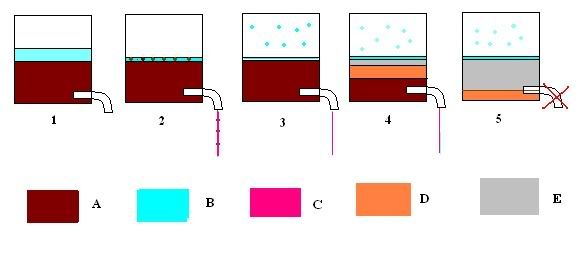Tequila. Let me show you what I think you mean! lol Forgive me if I am teaching you what you already know.

1. Mash on
2. Re-Circulating the wort
3. Fly sparging at same rate as out flow (keeping grain bed damp but not under water?)
4. Mid Sparge
5. End Sparge
A. Grain + High Concentration of sugars
B. Liquor
C. Wort run off
D. Grain + Medium Concentration of sugars
E. Grain + Practically no Concentration of sugars
As you can see the dead space is made up of wort which potentially is low in gravity and high in tanins. We dont want that stuff. So we can forget about dead space and grain absorbtion. They are pretty much irrelevant figures. Why would I want to know how much water and weak wort I am throwing away in to the compost heap?
Fly sparging should always be over before hitting the pre boil volume. If not, there is something wrong mechanically (with tun or grain) or with the procedure you are using.
Liquor then should be used to make up the volume in the boiler to bring it up to a correct ratio of preboil volume vs. gravity, so when evaporation does occur, you end up with the required brew length and correct volume. Obviously if the volumes:gravity aren't what was anticipated (due to mistakes, crap grain dodgy kit etc), then volumes can be tinkered with mid brew to compensate, but remember to adjust hops too.
My top tip for fly sparging is if mash eff is really low, taste the grains. How sweet are the grains? And an even better trick is you can work out where in the tun they are. Obviously if they aren't sweet, then there is something wrong with the conversion.
The diagrams are pretty self explanatory. I would suggest taking a step backward. For the next brew forget about total liquor volumes. Forget mash tun dead space and grain absorbtion. Even go as far as abandoning the HLT (as a container for the "total brewday liquor" and just use it as a container "liquor") and the computer all together (bar recipie creation if needed). It might feel like your brewing blind, but your not. Its just your placing to much significance in these figures.
The only thing that you should be aiming for is your preboil gravity and volume, and therefore more importantly post boil gravity and volume. And after all the dust has settled work out your brew house efficency.
As has been said on the post already. Accurate totals for brewday liquor takes thourough knowledge of your kit and processes and experience of the kit and recipies used. I would say the computer figures are rough estimates to help with pre-water treatment. But there are too many factors to be accurate with how much water is used on a brewday.
From what I have gathered, your brewing is fine, volumes and gravity are met. But your struggling to work out the reasons for these values. I hope this explains things, or if it doesnt, helps you understand why you cant work out everything?
Another question about fly sparging anyone?
I have always fly sparged. And when I was first taught how to do it, I was always under the understanding that the grain bed was to be moist, but not underwater. To float the grain bed seems almost against everything I was taught. Surely if it floats, the path of least resistance becomes the edges of the tun? Surely it should be compacted enough to not crark but not under an inch of water. Most people on here seem to have there sparge water as nearly as deep as a batch sparge.
Which is right, which is more efficient?
Cheers,
Matt







